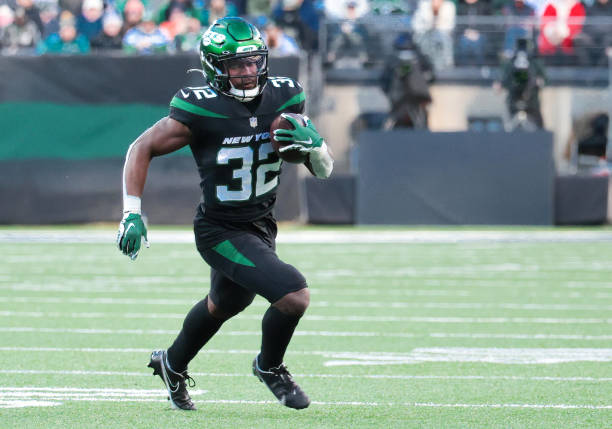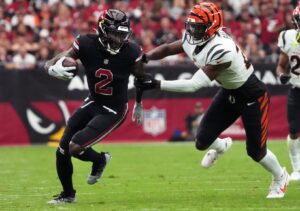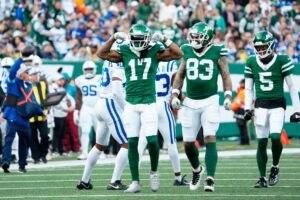Last season, running back Michael Carter emerged as the lead back in the New York Jets committee backfield. The 2021 fourth-round pick proved to be a playmaker in offensive coordinator Mike LaFleur’s scheme, producing 964 yards from scrimmage on just 50% of snaps in 14 games. In a backfield that often incorporates up to three running backs in a game plan, the Jets should make it a priority to add talent to help second-year quarterback Zach Wilson take that next step. That being said, New York should go into the off-season with the goal of filling out their running back committee with players that complement Carter in 2022.
New York Jets Must Build Backfield Around Michael Carter
Jets In-House Options
At the moment, Michael Carter, Ty Johnson, La’Mical Perine, and Austin Walter are the running backs under contract for 2022. This past season, Johnson saw the most playtime of the latter three, playing 40% of snaps in 16 games played. He finished the year with 610 yards from scrimmage, averaging 6.4 yards per touch. Johnson has been a solid contributor, but New York may look to upgrade, considering he is a liability as a blocker.
La’Mical Perine only played in four games, often times being a healthy scratch. As he enters his third season, he is not a lock to make the roster. As for Austin Walter, the Rice product performed well when called upon over the final few weeks, but not enough to guarantee him a role. All three have rather cheap contracts and having them compete during training camp and the preseason to make the team is the best call. Thus, leaving the Jets to scour the free agent market to add a veteran to complement Carter.
Free Agent Running Back Market
It is highly unlikely the Jets hand any running back a blank check. The last thing the Jets should do given all of their other needs is to overpay for a running back. Adding say Cordarrelle Patterson to play the Deebo Samuel, or a higher-volume Braxton Berrios role may be out of the question. But New York could still add one of the better running backs available.
One route is to sign a veteran downhill runner, one who offers more size and power compared to Carter. Melvin Gordon, who will be 29-year-old in 2022, has produced back-to-back seasons with over 1,000 yards from scrimmage. According to Spotrac, Gordon could command about $5 million a year, which the Jets certainly can afford. At a similar price tag, the Jets could look into Sony Michel, who had a great bounce-back season with the Los Angeles Rams.
Then again, maybe the Jets bring back Tevin Coleman, who averaged 4.2 yards per carry… when healthy. Coleman only played 11 games, starting just five, but would not be expensive to retain. New York could also try to sign away a running back from San Francisco that LaFleur is familiar with. Both Jeff Wilson and Raheem Mostert are set to hit the market, and neither will command significant contracts. Or maybe the Jets take a chance on Ronald Jones II or Rashaad Penny, who if healthy has starting upside. No matter what way they approach it, the Jets should sign a high-upside veteran running back to join Michael Carter.
Running Backs in the Draft
Here is where things get interesting. General Manager Joe Douglas is not going to use significant draft capital to take a running back, let alone give it away for one available via trade. Chances are, if the Jets draft a running back it will be on day three.
In the middle rounds, Brian Robinson Jr. from Alabama fits the bill for a downhill runner, and the same goes for Georgia’s Zamir White. Jerome Ford of Cincinnati is an early-down back, while Rachaad White from Arizona State is a taller back who would fit the Jets zone run game well. An intriguing option is Zach Wilson’s old BYU teammate, Tyler Allgeier, whose physical running style offers a “pop” that the Jets lacked in 2021.
Dividends of Complementing Carter
Again, as a rookie, Michael Carter proved more than capable of being the lead back in the Jets committee backfield. Going into 2022, he should have every opportunity to be “the guy”. So, the focus should become complimenting him. At 5’8” and 201 pounds, Carter is not a physically imposing back who can wear out defenses. With his low center of gravity, he is able to make defenses pay when running between the tackles. But the question becomes can he handle that over a 17-game season? Either way, in an off-season about adding talent and depth on offense, revamping the backfield should be on the Jets to-do list.
Main Photo: Embed from Getty Images






